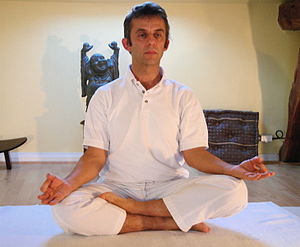Note: This is a project under development. The articles on this wiki are just being initiated and broadly incomplete. You can Help creating new pages.
Difference between revisions of "Sukhasana"
Chaithrika (talk | contribs) (Created page with "thumb|right|''Sukhasana'' The name comes from the Sanskrit words Sukha meaning "pleasure", and Asana (आसन, Āsana) meaning "posture" or "seat"....") |
(No difference)
|
Revision as of 17:45, 30 November 2016
The name comes from the Sanskrit words Sukha meaning "pleasure", and Asana (आसन, Āsana) meaning "posture" or "seat".
Sukhasana (soo-kah-sah-nah[needs IPA]; Sanskrit: सुखासन; IAST: Sukhāsana), Easy Pose, Decent Pose, or Pleasant Pose is an asana practised in yoga, buddhism and hinduism, similar to sitting in a simple cross-legged position. While opening the hips and lengthening the spine, the asana's relative ease on the knees makes it easier than siddhasana or padmasana for people with physical difficulties. Some schools do not consider it to be as effective for prolonged meditation sessions because it is easy to slump forward while sitting in it. For meditation, it is important that the spine be straight and aligned with the head and neck. But if the practitioner steadies the Sukhasana pose by putting pillows or blankets under the knees to create a steadiness, it may be easier to sit longer in Sukhasana for meditation without slumping forward. An additional blanket or pillow under the buttocks may also be beneficial and steadying. The 20th century Jnana Yoga guru Ramana Maharshi advocated it as suitable for attaining Enlightenment.
